
Latest News Regarding
Horn of Africa
Ethiopia calls “all capable” citizens to fight in Tigray war
Ethiopia calls “all capable” citizens to fight in Tigray war




Source: Wednesday August 11, 2021
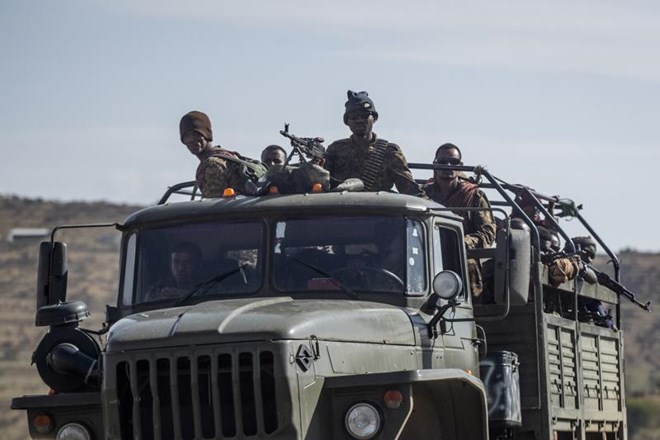
Ethiopia’s government on Tuesday summoned all capable citizens to war, urging them to join the country’s military to stop resurgent forces from the embattled Tigray region “once and for all.”
The call to arms is an ominous sign that all of Ethiopia’s 110 million people are being drawn into a conflict that Prime Minister Abiy Ahmed, a Nobel Peace Prize winner, once declared would be over within weeks.
The deadly fighting has now spread beyond Tigray into neighboring regions, and fracturing in Africa’s second most populous country could destabilize the entire Horn of Africa region.
advertisements
Tuesday’s announcement effectively ends the unilateral cease-fire the government declared in June as its military retreated from Tigray. It is also almost certain to magnify the toll of a nine-month war that has led to the massacre of thousands, widespread gang rapes and the displacement of entire communities, mostly Tigrayan. Hundreds of thousands of people in Tigray now face famine conditions in the world’s worst hunger crisis in a decade.
The prime minister’s summons chilled Tigrayans, even those outside Tigray, with the statement calling on all Ethiopians to be “the eyes and ears of the country in order to track down and expose spies and agents” of the Tigray forces. Witnesses and lawyers have said thousands of Tigrayans already have been detained during the conflict for their identity alone.
“The kind of war he’s calling for is on another level, it’s for a total annihilation of Tigray,” said Teklehaymanot G. Weldemichel, whose family remains trapped in the Tigray region. “‘Once and for all’ means to finish everyone out.”
The expansion of fighting has alarmed some people of other ethnicities, such as the Amhara, who fear that the Tigray forces, now on the offensive, will take revenge.
“We know the (Tigray People’s Liberation Front) is well-armed and the losers would again be the Amhara people,” Demissie Alemayehu, a U.S.-based professor who was born in the Amhara region, said shortly after the prime minister’s call to war. Without addressing Ethiopia’s root problems, including a constitution based on ethnic differences, he said, it will be “very difficult to talk about peace.”
The deputy head of the Amhara regional government, Fenta Mandefro, asserted that hundreds of Amhara residents have already been killed. “More people will be endangered if we continue adhering to a cease-fire ignored by the TPLF,” he said.
The call to join the military is so far not compulsory, but with access to parts of Ethiopia increasingly blocked, it’s difficult to know what kind of pressure is being applied. Spokespeople for Abiy’s office, the military and the Tigray emergency task force did not respond to questions.
Ethiopia’s sharply worded statement came after weeks of mobilization by the federal government, including military recruiting and blood donation drives, as Tigray forces pushed into the neighboring Amhara and Afar regions. On Tuesday, the spokesman for the Tigray forces, Getachew Reda, told The Associated Press that the prime minister “wants to send militia to the war front as cannon fodder” and called it unfortunate that “ill-trained, ill-equipped people” are now being pressed into the fight.
The war began as a political dispute. Tigray leaders dominated Ethiopia’s repressive government for nearly three decades, embittering many across the country by helping to put in place a system of ethnic federalism that led to ethnic tensions. When Abiy came to office in 2018, the Tigray leaders were sidelined.
Fighting began in November and took a stunning turn in June when the Tigray forces, strengthened by new recruits among Tigrayans horrified by the war’s atrocities, retook much of the region.
The Tigray forces now say they want to secure their long-blockaded region of 6 million people, end the fighting and see the prime minister leave office. Despite the resentment of many in Ethiopia, they are hoping for public support as they vow to press to the capital, Addis Ababa, if needed.
“If his government topples, that’s icing on the cake,” spokesman for the Tigray forces told the AP last week.
advertisementsLike Ethiopia’s government, they could use deprivation as means of pressure. Getachew confirmed that the Tigray forces’ aim in the Afar region is to control a crucial supply line to the rest of Ethiopia from neighboring Djibouti, on a major shipping lane. He called it “part of the game,” saying people in Tigray are starving.
“It’s not to spite the other parts of Ethiopia,” he said.
Last week the United Nations and the United States sent high-level officials to press Ethiopia’s government for more access to the Tigray, where telephone, internet and banking services remain cut off. But Ethiopia’s government has been angered by the international pressure over Tigray, especially as the fighting spreads.
Some 300,000 people have now been displaced outside Tigray, and this week the U.N. said it was “extremely alarmed” by reports that more than 200 people had been killed in attacks on displaced people in Afar. Ethiopia’s government blamed the Tigray forces, whose spokesman denied it.
The new statement from the prime minister’s office takes aim at some in the international community, blaming them for the “machinations of foreign hands” in the war, and alleging without evidence that some had been caught “red-handed supporting the (Tigray forces) under the disguise of humanitarian aid.” The government has suspended the operations of Doctors Without Borders and the Norwegian Refugee Committee, accusing them of “disseminating misinformation.”
The rhetoric in the government’s new statement “could well presage renewed restrictions on the humanitarian relief efforts in Tigray, reversing the already modest progress made in recent weeks,” Aly Verjee, a senior adviser at the United States Institute of Peace, told the AP.
The statement also “leaves little room for dialogue, and as we have seen, a war of words does little to end the war on the ground,” he said. “When the federal government calls Tigrayan forces terrorists and traitors, it is not likely to encourage restraint on the part of the Tigrayans, who are already militarily ascendant.”
The prime minister last month referred to the Tigray forces as “weeds” and “cancer,” bringing a swift warning from the U.S. about dehumanizing rhetoric. Since then, Ethiopia’s government has repeatedly said it is targeting the Tigray forces alone and the TPLF, which it declared a terrorist group earlier this year.
“The battle is not with Tigray but with the terrorist forces,” its new statement said.
Somalia Rejects Diplomatic Resolution of Maritime Dispute with Kenya
Somalia Rejects Diplomatic Resolution of Maritime Dispute with Kenya



Source: Maritime Executive
Wednesday August 11, 2021
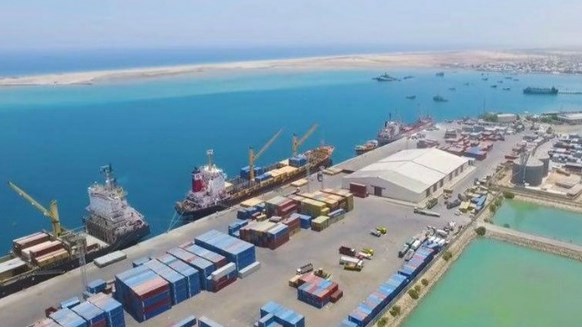
Somalia has rejected pressure for a diplomatic resolution to a longstanding maritime dispute with Kenya, maintaining the matter will be decided by the International Court of Justice (ICJ).
Despite a charm offensive by Kenya, Somalia reckons the ICJ must provide the final verdict on the dispute that has been running for close to a decade in which the neighbouring countries both claim ownership of large territories of the Indian Ocean with prospects of vast oil and gas deposits.
advertisements
Kenya’s Foreign Affairs Minister Raychelle Omamo made a maiden visit to Somalia’s capital, Mogadishu, where she held talks with Somali Prime Minister Mohamed Hussein Roble and sought to push the agenda of an out-of-court settlement with a deal brokered by the African Union.
However, Somalia stuck to its guns saying that the maritime dispute between both nations will be decided by The Hague-based court whose ruling is eagerly awaited after formal hearings in March this year. Kenya boycotted the hearings after accusing the ICJ of unfairness and unwillingness to delay the proceedings as a result of the COVID-19 pandemic.
“Somalia has underscored that an existing maritime dispute between both nations will be decided by The Hague-based International Court of Justice, or ICJ, despite several requests by Kenya to reach a settlement out of court,” said a statement from the prime minister’s office.
The two east African neighbors dispute over 38,000 square miles of territory in the Indian Ocean with prospects of vast oil and gas deposits, a matter Somalia wants the ICJ to arbitrate. The dispute has also led to frosty diplomatic relations over accusations and counter-accusations about interference with domestic affairs, territorial integrity, trade and security.
The statement noted that the two ministers “emphasized the importance of taking concrete measures to show respect for sovereignty, territorial integrity and political independence, which are the cornerstone of the relationship between the two countries.”
Somalia filed the case at the ICJ in 2014 on the basis that Kenya was encroaching on its marine territory and has repeatedly rejected calls to withdraw it and allow for a diplomatic resolution to the dispute.
Both countries are claiming ownership to the territory and have gone ahead to invite international companies to explore for gas and oil.
“The impact on the economy will be unprecedented”: Somalia creates a national payment system as part of its reconstruction after decades of wa
“The impact on the economy will be unprecedented”: Somalia creates a national payment system as part of its reconstruction after decades of war



Source: Market Research Telecast
Wednesday August 11, 2021
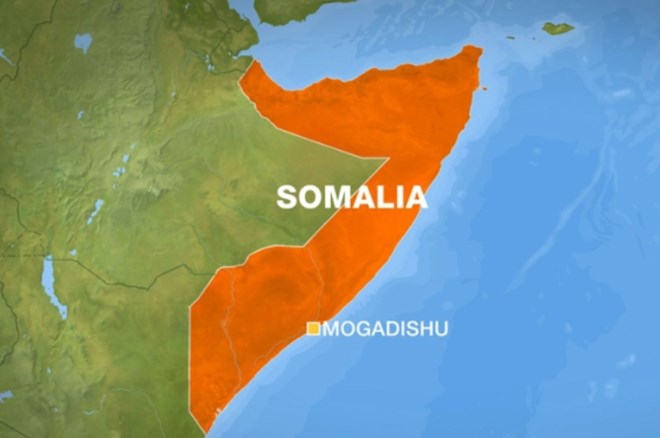
Somalia has created a national payment system under the financial industry development plan, after decades of political and economic instability.
The system will connect lenders with a clearing platform and allow real-time money transfers to be processed. Other advantages of the system include the interaction capabilities for debit and credit cards, mobile network operators and ATMs.
Now the country’s 13 credit banks can “be interoperable, be connected to the Central Bank’s clearing and settlement system and transact with each other,” said the Governor of the Central Bank of Somalia, Abdirahman M. Abdullahi, in an interview with Bloomberg.
The system will “facilitate transactions between sellers and their buyers in a more efficient way,” the bank representative said.
“The impact on the economy will be unprecedented. It will boost trade and business,” said Abdullahi, who estimates that the Somali economy could grow 2.9% this year.
Last July, the International Bank of Somalia launched the Visa Card international payment service.
The Central Bank of Somalia has also granted the first mobile phone-based financial services license to Hormuud Telecom and is studying the possibility of printing new Somali shillings banknotes, as they now use mostly US dollars.
IPCC report: ‘Code red’ for human driven global heating, warns UN chief
Source: IPCC report: ‘Code red’ for human driven global heating, warns UN chief
Unsplash/Marcus KauffmanA wildfire burns in a national park in Oregon, USA. 9 August 2021Climate and Environment
Climate change is widespread, rapid, and intensifying, and some trends are now irreversible, at least during the present time frame, according to the latest much-anticipated Intergovernmental Panel on Climate Change (IPCC) report, released on Monday.
Human-induced climate change is already affecting many weather and climate extremes in every region across the globe. Scientists are also observing changes across the whole of Earth’s climate system; in the atmosphere, in the oceans, ice floes, and on land.https://platform.twitter.com/embed/Tweet.html?creatorScreenName=UN_News_Centre&dnt=false&embedId=twitter-widget-0&features=eyJ0ZndfZXhwZXJpbWVudHNfY29va2llX2V4cGlyYXRpb24iOnsiYnVja2V0IjoxMjA5NjAwLCJ2ZXJzaW9uIjpudWxsfSwidGZ3X2hvcml6b25fdHdlZXRfZW1iZWRfOTU1NSI6eyJidWNrZXQiOiJodGUiLCJ2ZXJzaW9uIjpudWxsfSwidGZ3X3NwYWNlX2NhcmQiOnsiYnVja2V0Ijoib2ZmIiwidmVyc2lvbiI6bnVsbH19&frame=false&hideCard=false&hideThread=false&id=1424649118312435714&lang=en&origin=https%3A%2F%2Fnews.un.org%2Fen%2Fstory%2F2021%2F08%2F1097362&sessionId=5381e9cb42b10278f2a2a6fdf7f5d8a9528a0412&siteScreenName=UN_News_Centre&theme=light&widgetsVersion=1890d59c%3A1627936082797&width=550px
Many of these changes are unprecedented, and some of the shifts are in motion now, while some – such as continued sea level rise – are already ‘irreversible’ for centuries to millennia, ahead, the report warns.
But there is still time to limit climate change, IPCC experts say. Strong and sustained reductions in emissions of carbon dioxide (CO2) and other greenhouse gases, could quickly make air quality better, and in 20 to 30 years global temperatures could stabilize.
‘Code red for humanity’
The UN Secretary-General António Guterres said the Working Group’s report was nothing less than “a code red for humanity. The alarm bells are deafening, and the evidence is irrefutable”.
He noted that the internationally-agreed threshold of 1.5 degrees above pre-industrial levels of global heating was “perilously close. We are at imminent risk of hitting 1.5 degrees in the near term. The only way to prevent exceeding this threshold, is by urgently stepping up our efforts, and persuing the most ambitious path.
“We must act decisively now, to keep 1.5 alive.”
The UN chief in a detailed reaction to the report, said that solutions were clear. “Inclusive and green economies, prosperity, cleaner air and better health are possible for all, if we respond to this crisis with solidarity and courage“, he said.
He added that ahead of the crucial COP26 climate conference in Glasgow in November, all nations – especiall the advanced G20 economies – needed to join the net zero emissions coaltion, and reinforce their promises on slowing down and reversing global heating, “with credible, concrete, and enhanced Nationally Determined Contributions (NDCs)” that lay out detailed steps.
Human handiwork
The report, prepared by 234 scientists from 66 countries, highlights that human influence has warmed the climate at a rate that is unprecedented in at least the last 2,000 years.
In 2019, atmospheric CO2 concentrations were higher than at any time in at least 2 million years, and concentrations of methane and nitrous oxide were higher than at any time in the last 800,000 years.
Global surface temperature has increased faster since 1970 than in any other 50-year period over a least the last 2,000 years. For example, temperatures during the most recent decade (2011–2020) exceed those of the most recent multi-century warm period, around 6,500 years ago, the report indicates.
Meanwhile, global mean sea level has risen faster since 1900, than over any preceding century in at least the last 3,000 years.
The document shows that emissions of greenhouse gases from human activities are responsible for approximately 1.1°C of warming between 1850-1900, and finds that averaged over the next 20 years, global temperature is expected to reach or exceed 1.5°C of heating. Unsplash/Roxanne DesgagnésIce sheets in Jökulsárlón, Iceland.
Unsplash/Roxanne DesgagnésIce sheets in Jökulsárlón, Iceland.
Time is running out
The IPCC scientists warn global warming of 2°C will be exceeded during the 21st century. Unless rapid and deep reductions in CO2 and other greenhouse gas emissions occur in the coming decades, achieving the goals of the 2015 Paris Agreement “will be beyond reach”.
The assessment is based on improved data on historical warming, as well as progress in scientific understanding of the response of the climate system to human-caused emissions.
“It has been clear for decades that the Earth’s climate is changing, and the role of human influence on the climate system is undisputed,” said IPCC Working Group I Co-Chair, Valérie Masson-Delmotte. “Yet the new report also reflects major advances in the science of attribution – understanding the role of climate change in intensifying specific weather and climate events”.
Extreme changes
The experts reveal that human activities affect all major climate system components, with some responding over decades and others over centuries.
Scientists also point out that evidence of observed changes in extremes such as heatwaves, heavy precipitation, droughts, and tropical cyclones, and their attribution to human influence, has strengthened.
They add that many changes in the climate system become larger in direct relation to increasing global warming.
This includes increases in the frequency and intensity of heat extremes, marine heatwaves, and heavy precipitation; agricultural and ecological droughts in some regions; the proportion of intense tropical cyclones; as well as reductions in Arctic sea ice, snow cover and permafrost.
The report makes clear that while natural drivers will modulate human-caused changes, especially at regional levels and in the near term, they will have little effect on long-term global warming. Unsplash/Maxim TolchinskiyAir pollution from power plants contributes to global warming.
Unsplash/Maxim TolchinskiyAir pollution from power plants contributes to global warming.
A century of change, everywhere
The IPCC experts project that in the coming decades climate changes will increase in all regions. For 1.5°C of global warming, there will be increasing heat waves, longer warm seasons and shorter cold seasons.
At 2°C of global warming, heat extremes are more likely to reach critical tolerance thresholds for agriculture and health.
But it won’t be just about temperature. For example, climate change is intensifying the natural production of water – the water cycle. This brings more intense rainfall and associated flooding, as well as more intense drought in many regions.
It is also affecting rainfall patterns. In high latitudes, precipitation is likely to increase, while it is projected to decrease over large parts of the subtropics. Changes to monsoon rain patterns are expected, which will vary by region, the report warns.
Moreover, coastal areas will see continued sea level rise throughout the 21st century, contributing to more frequent and severe coastal flooding in low-lying areas and coastal erosion.
Extreme sea level events that previously occurred once in 100 years could happen every year by the end of this century.
The report also indicates that further warming will amplify permafrost thawing, and the loss of seasonal snow cover, melting of glaciers and ice sheets, and loss of summer Arctic sea ice.
Changes to the ocean, including warming, more frequent marine heatwaves, ocean acidification, and reduced oxygen levels, affect both ocean ecosystems and the people that rely on them, and they will continue throughout at least the rest of this century. UNDP/Michael AtwoodThe aftermath of Hurricane Irma in Barbuda.
UNDP/Michael AtwoodThe aftermath of Hurricane Irma in Barbuda.
Magnified in cities
Experts warn that for cities, some aspects of climate change may be magnified, including heat, flooding from heavy precipitation events and sea level rise in coastal cities.
Furthermore, IPCC scientists caution that low-likelihood outcomes, such as ice sheet collapse or abrupt ocean circulation changes, cannot be ruled out.
Limiting climate change
“Stabilizing the climate will require strong, rapid, and sustained reductions in greenhouse gas emissions, and reaching net zero CO2 emissions. Limiting other greenhouse gases and air pollutants, especially methane, could have benefits both for health and the climate,” highlights IPCC Working Group I Co-Chair Panmao Zhai.
The report explains that from a physical science perspective, limiting human-induced global warming to a specific level requires limiting cumulative carbon dioxide emissions, reaching at least net zero CO2 emissions, along with strong reductions in other greenhouse gas emissions.
“Strong, rapid and sustained reductions in methane emissions would also limit the warming effect resulting from declining aerosol pollution”, IPCC scientists underscore. UNICEF/SokhinA 16-year-old child swims in the flooded area of Aberao village in Kiribati. The Pacific island is one of the countries worst affected by sea-level rise.
UNICEF/SokhinA 16-year-old child swims in the flooded area of Aberao village in Kiribati. The Pacific island is one of the countries worst affected by sea-level rise.
About the IPCC
The Intergovernmental Panel on Climate Change (IPCC) is the UN body for assessing the science related to climate change. It was established by the United Nations Environment Programme (UNEP) and the World Meteorological Organization (WMO) in 1988 to provide political leaders with periodic scientific assessments concerning climate change, its implications and risks, as well as to put forward adaptation and mitigation strategies.
In the same year the UN General Assembly endorsed the action by the WMO and UNEP in jointly establishing the IPCC. It has 195 member states.
Thousands of people from all over the world contribute to the work of the IPCC. For the assessment reports, IPCC scientists volunteer their time to assess the thousands of scientific papers published each year to provide a comprehensive summary of what is known about the drivers of climate change, its impacts and future risks, and how adaptation and mitigation can reduce those risks.https://w.soundcloud.com/player/?url=http://api.soundcloud.com/tracks/1102948201&show_artwork=true
‘Before our very eyes’
Multiple, recent climate disasters including devastating flooding in central China and western Europe have focused public attention as never before, suggested Inger Andersen, Executive Director of the UN Environment Programme (UNEP).
“As citizens and as businesses and as governments, we are well aware of the drama,” she said “The drama exists, we have seen it and we heard about it in every news bulletin. And that’s what we need to understand, that the expression of what the science says is exhibited before our very eyes, and of course what this excellent report does is, it projects those scenarios outward, and tells us, if we do not take action, what could be the potential outcomes, or if we do take action, what will be a very good outcome.”
Climate adaption critical
Apart from the urgent need for climate mitigation, “it is essential to pay attention to climate adaptation”, said the WMO chief, Peteri Taalas, “since the negative trend in climate will continue for decades and in some cases for thousands of years.
“One powerful way to adapt is to invest in early warning, climate and water services“, he said.”Only half of the 193 members of WMO have such services in place, which means more human and economic losses. We have also severe gaps in weather and hydrological observing networks in Africa, some parts of Latin America and in Pacific and Caribbean island states, which has a major negative impact on the accuracy of weather forecasts in those areas, but also worldwide.
“The message of the IPCC report is crystal clear: we have to raise the ambition level of mitigation.”♦ Receive daily updates directly in your inbox – Subscribe here to a topic.
Kenya-Somalia border dispute top agenda in CS Omamo’s Mogadishu visit
Kenya-Somalia border dispute top agenda in CS Omamo’s Mogadishu visit




Source: theSTAR, Sunday August 8, 2021
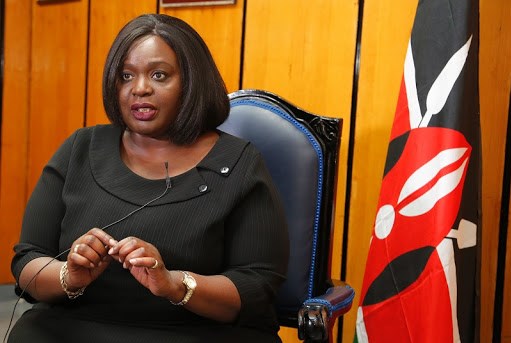
Foreign Affairs Cabinet Secretary Raychelle Omamo is expected in Somalia on Sunday to discuss the long-standing maritime border dispute.
Somalia Foreign Affairs ministry officials confirmed to the Star that CS Omamo will be in Mogadishu on Sunday, which is her maiden trip to the country.
There she will meet her counterpart Mohamed Abdirizak, Prime Minister Hussein Roble, and later hold talks with President Mohamed Farmaajo.
“The agenda is the border dispute that is currently at the International Court of Justice. The Honourable minister [CS] will also meet our Foreign minister, the PM and His Excellency the President,” the official said.
advertisements
Kenya had on July 19, 2021 asked the AU Commission to offer technical assistance regarding border issues with Somalia through a note verbale to the continental commission.
“In this regard, the Commission wishes to communicate that it stands ready to provide technical assistance regarding border matters to all Africa Union Member States through its Africa Union Border Programme (AUBP) upon a joint request.”
“To this effect, the Commission will initiate the process of further consultations between the two parties in the Kenya-Somalia border issues in line with the AU legal instruments,” the note verbale dated July 28 states.
Foreign Affairs PS Macharia Kamau did not respond to inquiries about the visit.
Kenya has been pushing for political negotiations in the dispute against the ICJ route.
ICJ CASE
In August 2014, Somalia formally asked the ICJ “to determine, on the basis of international law, the complete course of the single maritime boundary dividing all the maritime areas appertaining to Somalia and to Kenya in the Indian Ocean”.
The matter is yet to be concluded following deferments and Kenya’s withdrawal on March this year.
Kenya got alarmed when Somalia displayed contested oil and gas blocks within its territory for auction in London in 2019.
The fight for the ocean resources put Kenya’s interests at risk, with the Somali Parliament pushing for the withdrawal of the Kenya Defence Forces.
Foreign Affairs PS Macharia Kamau then said the auction happened on February 7, 2019 in London. Consequently, Kenya recalled its ambassador over the alleged auctioning of oil and gas blocks and expelled the Somalia envoy.
The two states resumed relations in May of that year after talks on the maritime row. Welcoming back the envoy, PS Kamau said he hoped “for even better days ahead.”
In May this year, Somalia restored diplomatic relations with Kenya after mediation by the Qatari Emir Sheikh Tamim Al Thani.
In a statement by the Ministry of Information, Somalia said it was resuming the relations “in keeping with the interests of good neighbourliness”.
Mogadishu severed ties with Nairobi again on December 15, 2020, over claims of interference with its domestic politics, which the Ministry of Foreign Affairs said were unfounded.
RAPPROCHEMENT
In June, Kenya lifted the ban on flights to and from the country after a month, “in the hope that full normalisation of bilateral relations will occur”.
The respective countries have since reopened their embassies in Mogadishu and Nairobi.
Somalia’s Foreign Ministry said the resumption of full diplomatic relations would be “a positive start to the commencement of bilateral discussions between the two nations”.
On June 21, President Uhuru Kenyatta maintained that his government will not cede even an inch of its soil to anyone or any state.
In what appeared to be a reference to the Kenya-Somalia border dispute, President Kenyatta said Kenya is ready to defend its territorial integrity as it has defended the peace of other states.
“As a peace-loving country, we are not the kind to be attacked or threatened or even allow an inch of our country to end up in the hands of other people. We are ready to defend ourselves just as we have defended peace in other states,” he said during a security tour in Boni area.
Kenya FM arrives in Mogadishu for talks with Somali leader
Kenya FM arrives in Mogadishu for talks with Somali leader




Source: Sunday August 8, 2021
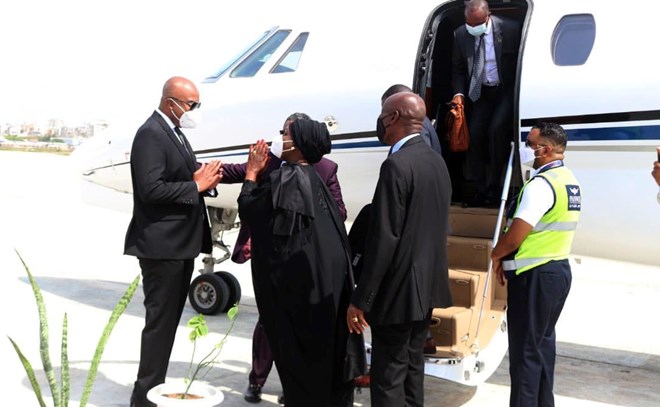
MOGADISHU (HOL) – Kenya foreign Minister, Raychelle Omamo has today arrived in Somali capital, Mogadishu barely two months after her country lifted flight ban on Somalia.
Omamo and her delegation who arrived mid-morning at Mogadishu Airport were received by Somali counterpart, Mohamed Abdirisack and other government officials.
advertisements
She will meet with minister Abdirisack, Prime Minister Mohamed Hussein Roble, and later hold talks with President Mohamed Abdullahi Farmaajo.
This is Omamo’s maiden trip to the horn of Africa nation ever since she assumed the office.
Last June, Kenya lifted the ban on flights to and from the country after a month, “in the hope that full normalisation of bilateral relations will occur.”
More to follow.
PM Roble responds to Farmaajo, affirms ‘full authority
PM Roble responds to Farmaajo, affirms ‘full authority’




Source: Hiiraan Online, Sunday August 8, 2021
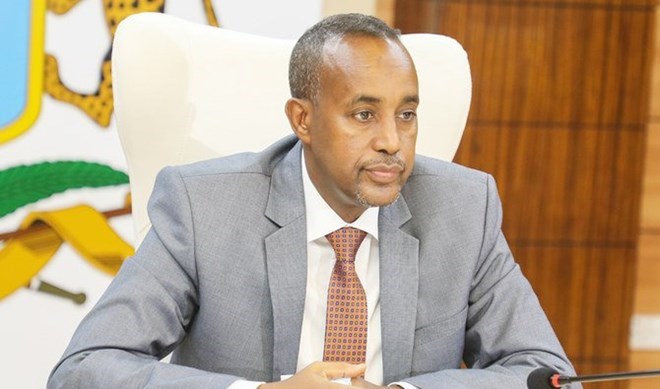
MOGADISHU (HOL) – Prime Minister Mohamed Roble has responded to a decree issued by President Mohamed Farmaajo Saturday night calling on his cabinet to ‘proceed with business as usual’.
In what could be seen as a rejection of the decree, PM Roble said in a statement the Provisional Constitution granted the Council of Ministers full authority until a new government comes into being.
“In accordance with Article 97, Clause 1 of the Provisional Constitution, the executive power of the Federal Republic shall be vested in the Council of Ministers, which shall act in accordance with the Constitution, and shall have the highest authority,” the statement read in part.
A decree issued by Farmaajo Saturday evening ordered all government officials not to enter into any agreements both locally and international until a new government is elected.advertisements
The outgoing President argued that the outgoing government does not have authority to conduct business on behalf of the state.
The President’s directive came ahead of a visit to the country by Kenyan foreign minister Raychelle Omamo.
The Kenyan minister met with Roble and handed him an invite from President Uhuru Kenyatta.
There had been reports Kenya was seeking a lift on khat ban by Somalia; a matter which may have necessitated Farmaajo’s move.
But in his response, Roble said his government had authority to enter into agreements.
“The government is also responsible for enforcing the law, maintaining security, protecting the interests of the country and the people of Somalia, and the National Constitution mandates the Federal Government to negotiate foreign aid, trade, treaties or issues. important in relation to international agreements,” Roble said.
The exchanges are likely to widen the rift between the two leaders.
Somali president freezes new trade, security pacts until after polls
Somali president freezes new trade, security pacts until after polls




Source: XINHUA, Sunday August 8, 2021
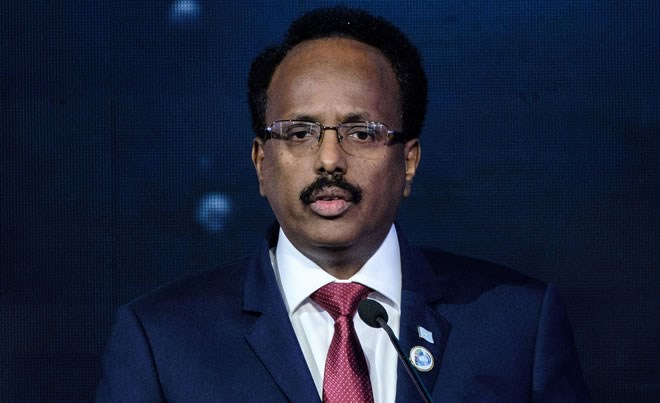
Somali President Mohamed Farmajo has issued a directive barring all government officials and public institutions from entering into new economic, political and security agreements during the electioneering period.
Farmajo said the directive which is aimed at safeguarding the national assets and sovereignty of Somalia will remain in force until the next government is sworn in and takes office.
“Until after the elections, all ministries and government agencies are prohibited from entering agreements or talks on behalf of the Federal Government of Somalia that affect the future, sovereignty, the land and the sea of our country,” he said in a directive released on Saturday evening.
advertisements
Analysts say the latest executive order will stop reported dealings that have been the norm during the electioneering period.
“Until after the elections, all new trade agreements with other countries remain suspended,” the president said.
Farmajo said in issuing the directive, he took into account the prevailing political situation in the country and the constitutional responsibilities of the two Houses of Parliament in ratifying agreements entered between Somalia and other countries, institutions and international companies
Farmajo said the executive order is meant to provide a conducive environment for the ongoing electoral process.
He instructed all government institutions to uphold and protect the dignity, nationhood and gains made in recent years.
Somalia which has kicked off elections for representatives of the Upper House is due to hold presidential elections by October.
Tigray Forces Take Control of Lalibela, UN World Heritage Site
Tigray Forces Take Control of Lalibela, UN World Heritage Site
Source: Reuters published on 5 August 2021 an article titled “Tigrayan Forces Take Control of Ethiopia’s Lalibela, a UN World Heritage Site.“
The Washington Post published on 5 August 2021 an article titled “Tigrayan Forces Take Control of Lalibela UNESCO Heritage Site” by Sammy Westfall.
The Tigray Defense Force reportedly entered the town of Lalibela and World Heritage Site on 5 August without facing any opposition, although numerous Amhara residents fled the area. The US called on the Tigrayan forces to respect the cultural heritage of the town and earlier had urged Tigrayan forces to withdraw from Amhara Region. At the beginning of the conflict, Amhara militia and central government forces took control of historically significant Aksum in western Tigray Region.
USAID Administrator Calls for Tigrayan Troops to Withdraw from Amhara and Afar Regions
Source: USAID Administrator Calls for Tigrayan Troops to Withdraw from Amhara and Afar Regions
The Voice of America published on 4 August 2021 a story titled “USAID Head Pushes for Humanitarian Aid Access in Tigray.”
Source, USAID Administrator Samantha Power, in Addis Ababa, called on the government of Ethiopia to allow clear access for humanitarian aid to Tigray Region and for the Tigray Defense Forces to withdraw from neighboring Amhara and Afar Regions
Conflict Blocks Chinese-built Ethio-Djibouti Rail Link
Conflict Blocks Chinese-built Ethio-Djibouti Rail Link
Source: The Reporter of Ethiopia published on 31 July 2021 an article titled “Ethio-Djibouti Line Remains Closed” by Brook Abdu.
The Ethio-Djibouti rail line shut down on 24 July and remained closed as of 31 July due to conflict on the border between Afar and Somali Regions. The conflict in Tigray Region may also be linked to the closure.

Labels: Afar Region, China, conflict, Djibouti, Ethiopia, infrastructure, railway, Somali Region, Tigray Region, TPLF, transportation
Lessons from a Decade of South Sudanese Independence
Lessons from a Decade of South Sudanese Independence
Source: The Africa Center for Strategic Studies published on 29 June 2021 an analysis titled “Lessons from a Decade of South Sudanese Statehood” by Luka Biong Deng Kuol.
So much went wrong in South Sudan over the past 10 years of independence but many South Sudanese are still proud that they at least have a country of their own that they can fix one day.

Labels: constitution, corruption, DDR, Dinka, employment, governance, justice, Nuer, Riek Machar, rule of law, Salva Kiir, security, South Sudan
US Supports Ethiopia’s Ceasefire in Tigray
US Supports Ethiopia’s Ceasefire in Tigray
Source: The US State Department posted on 29 June 2021 a statement titled “Ceasefire in Ethiopia’s Tigray Region.”
It called on all parties to commit to an immediate, indefinite, negotiated ceasefire, an inclusive dialogue that preserves the unity, sovereignty and territorial integrity of the Ethiopian state, unhindered humanitarian access, independent mechanisms for accountability of human rights violations and abuses, and the immediate, verifiable withdrawal of all Eritrean forces from Ethiopian territory.

Labels: cease fire, Eritrean Defense Forces, Ethiopia, human rights, humanitarian crisis, national dialogue, Tigray Region, US
The Case Against Ethiopia’s Ethnic Federalism
The Case Against Ethiopia’s Ethnic Federalism
Source: Ethiopia Insight posted on 30 June 2021 a commentary titled “Ethnic Federalism: A Theory Threatening to Kill Ethiopia” by Kassahun Melesse, Oregon State University.
The author argues that ethnic federalism has been a major barrier to national unity and common public institutions. Ethiopia must move away from its Soviet-inspired ethnic federalism to achieve peace, prosperity and democracy.

Labels: Amhara Region, EPRDF, Ethiopia, ethnic federalism, governance, language, Oromia, Prosperity Party, Soviet Union, Tigray Region, TPLF
Somalia, Kenya discuss deepening ties after end of rift
Somalia, Kenya discuss deepening ties after end of rift




Source: AA, Thursday July 1, 2021
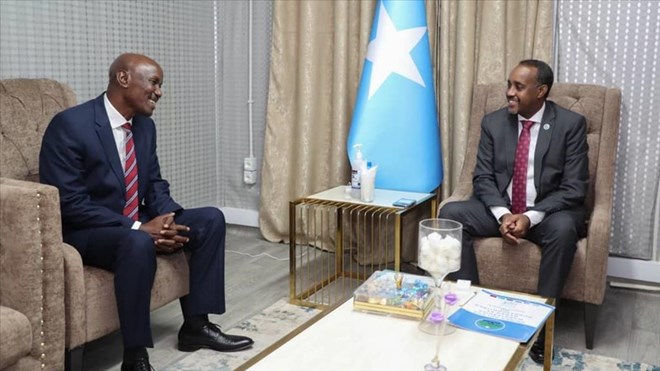
Somalia and Kenya on Wednesday discussed the need to deepen bilateral relations between the two East African nations, which recently restored ties after a months-long dispute.
Somali Prime Minister Mohamed Hussein Roble’s meeting with Kenya’s Ambassador to Somalia Lucas Tumbo in the capital Mogadishu was the first since the restoration of diplomatic relations between the two neighboring countries.
“The PM and the Ambassador discussed the need to deepen bilateral relations and enhance cooperation,” said the office of the Somali prime minister in a brief statement after the meeting.
advertisements
Somalia cut off diplomatic ties with Kenya last December, accusing Nairobi of interfering in Mogadishu’s internal affairs.
Security, education, and trade relations between the two neighbors were severed for some five months, until Mogadishu announced in May that it was ready to restore ties with Nairobi, citing the interests of both countries.
Earlier this month Kenya accepted Somalia’s request to reopen its diplomatic mission in the capital Mogadishu after the restoration of ties.
Somalia Opposition Welcomes Election Plan, but Security Threats Remain
Somalia Opposition Welcomes Election Plan, but Security Threats Remain




Source: VOA, Thursday July 1, 2021
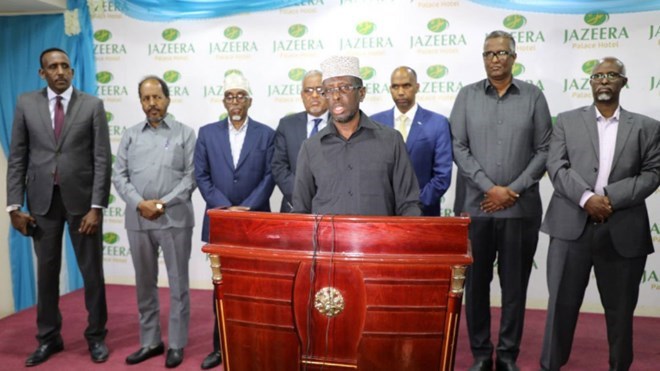
Somalia’s opposition politicians and the public have welcomed a deal to hold delayed indirect presidential elections in October, with lawmakers chosen in July and August. But analysts note unrest and terrorist attacks are still a risk.
advertisements
Somalia’s opposition politicians welcomed the new election schedule reached Tuesday in Mogadishu after a meeting of federal and state leaders.
Lawmaker Mohamed Hassan Idris said the opposition was looking forward to a quick implementation to avoid further delays and unrest.
“So far, we have no concerns,” Hassan said. “It is on a very welcoming stage; the schedule has been agreed by the leaders and the electoral committees, both from the federal and member states levels.” He said leaders would need to continue discussions, “and we hope they continue to solve any likely obstacles.”
Process stalled
Somalia’s indirect elections were to take place in February, but the process was stalled over opposition concerns about free elections.
The opposition accused President Mohamed Abdullahi Mohamed, known as Farmajo, of stacking poll committees with his allies.
Farmajo denied the allegation but raised international eyebrows in April when he signed into law a two-year extension of terms in office, including his.
The move sparked days of street clashes in April in Mogadishu between split loyalty security forces, renewing fears of a return to clan violence.
Under international pressure, Farmajo nullified the extension and returned to talks with the opposition for holding elections.
The deal reached Tuesday was largely applauded by Mogadishu residents like university student Hassan Ahmed, 27.
He said he was happy and excited about the new election schedule. Some worried about the previous timeline, he said, and the disagreements between the leadership of the federal government and the regional states.
Election schedule
The indirect elections will begin in July with delegates chosen by clans selecting members of the lower house of parliament.
State governments will select senators beginning in August. The chosen lawmakers will then vote for the next president on October 10.
Despite the breakthrough, there is still a threat from al-Shabab militants, said independent security analyst Dahir Korow.
“Al-Shabab is trying to disrupt the Somali election process through suicide bombings and IED [improvised explosive device] attacks, mainly the venues of the process across the regions,” Korow said. “However, it is also very significant to note that the democratic process will attract high-security alert both from Somali security agencies and their international peacekeeping partners such as AMISOM. Remember, the training and capacity building for Somali security agencies have been improving in recent years while al-Shabab’s have been decreasing.”
The U.S. Embassy in Somalia urged continued constructive dialogue among Somali leaders to achieve peaceful and transparent elections.
Somalia originally planned to hold direct, one-person-one-vote elections, which would have been the first in decades. But the plan was scrapped in September because of a lack of infrastructure and concerns about security.
Ethiopia Calls for Immediate Cease Fire in Tigray
Ethiopia Calls for Immediate Cease Fire in Tigray
Source: the Associated Press published on 28 June 2021 an article titled “Ethiopia Declares Immediate, Unilateral Cease-fire in Tigray” by Cara Anna.
Ethiopia’s government declared on 28 June an immediate, unilateral cease fire in its Tigray Region after nearly eight months of deadly conflict. The statement came shortly after the Tigray interim administration, appointed by the federal government, fled the regional capital, Mekele, and called for a cease fire on humanitarian grounds so that desperately needed aid can be delivered. There was no immediate comment from the Tigray Defense Forces or the government of Eritrea, which has troops in Tigray.

Labels: Amhara militia, atrocities, cease fire, ENDF, Eritrea, Eritrean Defense Forces, Ethiopia, famine, humanitarian crisis, Tigray Defense Forces, Tigray Region
Tigray Defense Forces Reportedly Control Capital of Tigray
Tigray Defense Forces Reportedly Control Capital of Tigray
Source: Deutsche Welle published on 28 June 2021 an article titled “Ethiopia Declares ‘Unilateral’ Cease-fire in Tigray, as Rebel Troops Reenter Capital.”
In what appears to be a highly fluid situation, Tigray Defense Forces claim to be back in control of Mekele, the capital of Tigray Region. The status of Ethiopian National Defense Forces and Eritrean Defense Forces is not clear.

Labels: Abiy Ahmed, cease fire, ENDF, Eritrea, Eritrean Defense Forces, Ethiopia, Tigray Defense Forces, Tigray Region, TPLF, UNICEF
WHO and Sweden sign agreement to further strengthen the capacity of the National Institute of Health and improve digitalization of health information in Somalia
WHO and Sweden sign agreement to further strengthen the capacity of the National Institute of Health and improve digitalization of health information in Somalia



Source: WHO, Tuesday June 29, 2021
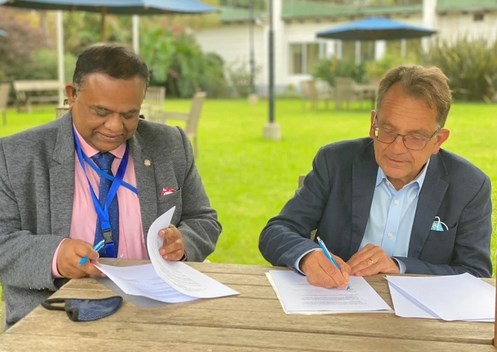
On 16 June, Dr Mamunur Malik, WHO Representative to Somalia, and H.E. Staffan Tillander, Swedish Ambassador to Somalia, signed an agreement, totalling 4 300 000 SEK (US$ 517 868), aimed at strengthening the National Institute of Health and health information systems in Somalia, through the financing of 2 senior WHO national staff positions.
The signature of this agreement marks years of close collaboration and partnership between WHO and Sweden in Somalia. It is built upon 2 non-financial memoranda of understanding signed between WHO and the Public Health Agency of Sweden, and between WHO and the SPIDER Center (Stockholm University).
The former aims to support the establishment of an independent national institute of health in Somalia, while the latter aims to strengthen the digitalization of health information and the development of an integrated disease surveillance and response system across the country.
This agreement will therefore enable the WHO Somalia country office to recruit and retain 2 senior level national staff to support the activities of the National Institute of Health and other disease surveillance functions to support SPIDER-related activities.advertisements
Both staff members will act as WHO’s primary focal points for close engagement and technical collaboration with these agencies, health authorities, as well as other relevant partners.
“This agreement marks a remarkable chapter in the history of collaboration between WHO and Sweden in Somalia. The collaboration and agreement aim at improving health information management system in Somalia by working closely with SPIDER and will provide critical human resources support to operationalize and transform the newly functioning National Institute of Health of Somalia as a premier centre in the country for public health research, front-line health workforce development, public health laboratory, emergency preparedness and outbreak response, as well as for leading disease-specific control programmes in the country. We are confident that this support of Sweden will go a long way in protecting the vulnerable and promoting health with a view to building a safer world for everyone in Somalia,” said Dr Malik, WHO Representative.
“Access to health care touches people in their everyday life. Somalia is step by step rebuilding its health systems, around the country, in towns, villages, for girls and boys, mothers and fathers, young and old. Working with WHO to support these life-saving efforts is part of our partnership with the Somali people,” said H.E. Staffan Tillander, Swedish Ambassador to Somalia.
This important contribution from Sweden to WHO in Somalia further consolidates the innovative partnership that already exists between the two, as well as the collective efforts of both to achieve better health outcomes for all Somalis towards universal health coverage and health for all.
Kenya faces ports competition with Somaliland, TZ projects
Kenya faces ports competition with Somaliland, TZ projects




Source: theSTAR,Tuesday June 29, 2021
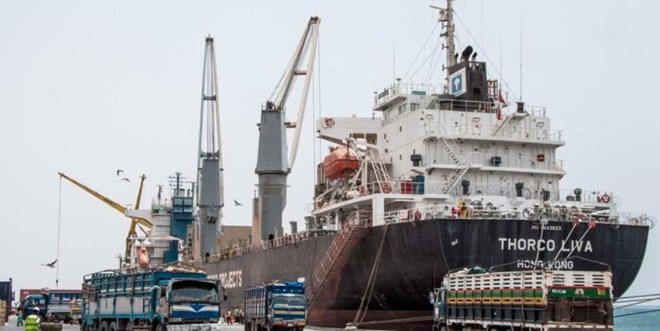
Regional competition on ports is shaping up as Somaliland and Tanzania angle themselves to give Kenya a run for its money in shipping and logistics.
Dubai Ports World (DP World) and Somaliland have opened a new terminal at Berbera Port, and announce second phase expansion and ground breaking for an economic zone.
DP World is an Emirati multinational logistics company based in Dubai, United Arab Emirates. It specialises in cargo logistics, port terminal operations, maritime services and free trade zones.
Berbera Port’s new container terminal has capacity for 500,000 TEUs a year with its second phase expansion expected to increase capacity up to two million TEUs a year.
Berbera Economic Zone under development aims to attract investment and new businesses with an expanded port, economic zone and Berbera corridor expected to transform Berbera into an integrated maritime, industrial and logistics hub in the Horn of Africa.
“The completion of the first phase has made our vision of establishing Berbera with its strategic location into a major trade hub in the region a reality,” Somaliland President Muse Bihi Abdi said.
DP World Group Chairman and CEO Sultan Ahmed Bin Sulayem has termed Berbera as a “viable, efficient and competitive option for trade in the region, especially for Ethiopian transit cargo”, meaning it is likely to give Kenya’s new Lamu Port stiff competition.
The new container terminal with a deep draft of 17metres, a quay of 400metres and three ship-to- shore gantry cranes, can handle the largest container vessels in operation today, though remains way below in annual throughput capacity compared to Mombasa.
Part of the overall Berbera plan and modelled on DP World’s Jebel Ali Free Zone in Dubai, the economic zone is linked to the port and strategically located along the Berbera to Wajaale road (Berbera Corridor).
The Berbera Corridor road upgrade project, funded by the Abu Dhabi Fund for Development (ADFD) and the UK’s Department for International Development (DFID), and the Hargeisa Bypass Road funded by UK Aid, is set for completion in quarter four, 2021 and quarter three 2022, respectively.
The road will link to the existing modern highway on the Ethiopian side and position Berbera as a direct, fast, and efficient trade route for Ethiopian transit cargo.
Tanzania on the other hand is looking to revive the $10 billion(Sh1.1 trillion) Bagamoyo port project on the eastern coast of the country, President Samia Suluhu told the country’s private sector players in Dar es Salaam on Saturday.
This will create a second major sea port for Tanzania complementing the Dar es Salaam Port, which is currently giving Kenya competition for cargo destined for the hinterland through the Central Corridor, mainly Rwanda.
Tanzania inked a framework agreement with China Merchants Holdings International in 2013 to construct the port and a special economic zone aimed at at transforming the country into a trade and transport, rivaling Kenya.
It however stalled after the late President John Magufuli poked holes on the deal offered to Tanzania, saying it was not commercially viable.
Kenya is meanwhile eying business in Ethiopia and South Sudan with the newly launched Lamu Port which is part of the Sh 2.5 trillion Lamu Port South Sudan Ethiopia Transport (LAPSSET) Corridor project.
advertisements
Kenya officials are in Ethiopia to market the facility.
Yesterday, they together with South Sudan and Ethiopian officials met in Addis Ababa to formalise a proposed ‘Regional Framework Body’ that will see the three countries operate and manage the regional infrastructure project “in a much more coordinated manner.”
Kenya Ports Authority (KPA) is however confident that investment in Kenya’s ports and logistics sector, including automation of systems, will continue giving the country a competitive edge over regional peers.
Mombasa Port has an annual capacity of over 1.4 million TEUs and close to 35 million tonnes, which makes it a leading facility in the region.
Lamu Port however has a bigger vessel handling capacity than Mombasa, according to acting managing director Rashid Salim.
Its berths are 400 metres long compared to Mombasa’s 300 meters average while the depth at Lamu is up to minus 17.5 meters against 15 meters at the Port of Mombasa, amking it able to handle post-panamax ships.
“Port competition depends on the geographical location and the cost of the port and cargo movement. Different ports have different advantages but at the end of the day, it depends with the efficiency of the port,” Rashid told journalist during a recent port visit.

